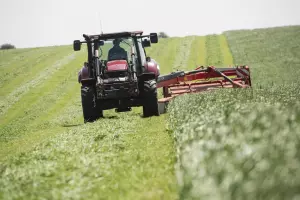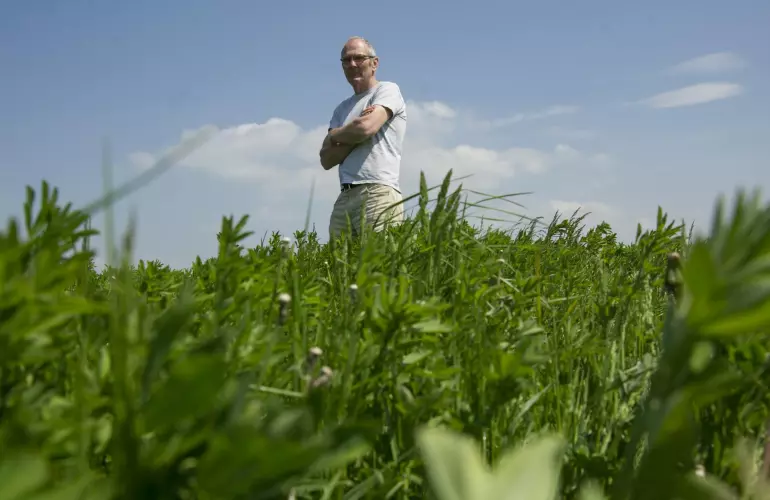
One Cotswold organic farm has been trialling lucerne as an alternative to red clover. Georgina Gater-Moore reports on progress as the 23-acre crop goes into a second harvest season.
Dick Roper, who has been farm manager at 3,500-acre Broadfield Farm for 40 years, has been a fan of red clover for many years. However, with its limitations for grazing ewes around mating time and disease risk when grown continuously, Dick felt that it would be interesting to see how lucerne might offer new opportunities - supplying silage for fattening cattle, grazing for fat lambs, and improving soil health in the organic rotation.
Lucerne is a forage legume that can average around 14t of dry matter per hectare. Capable of surviving on very dry land and with an exceptionally deep rooting system, it would be of benefit to both the organic and conventional farming system for improving soil structure and reducing the need for nitrogen fertilisers. There is a perception that lucerne is difficult to establish, however if the guidelines are followed and it is not grazed too hard in the first year of growth it can be an exceptionally productive crop with a high protein content.

“The farm is based on dry Cotswold brash, it’s traditionally very good lucerne ground, with an average pH of 7.8 and soil organic matter levels between six and eight percent,” says Dick. “We currently work on a rotation that allows us to get the most we can out of the soil, whilst also putting the most back in. It’s all a balancing act.
“We have fields down to a red clover ley for three years, cutting it once each spring and then weaning lambs onto it. After the third year of grazing we plough the field and it goes into spring barley. The residual nitrogen in the soil helps us to produce a high-grade malting crop which we send to Germany for brewing.
Dick establishes most of the leys on the farm by undersowing, and the lucerne was no exception.
“I was advised not to undersow the lucerne, but with the cost of direct drilling being at least £50-60 per acre just on cultivations, I decided against that. It therefore didn’t cost us any more to sow the lucerne than a grass ley, apart from seed costs. The lucerne was undersown with spring barley (drilled at a reduced rate of 150kg/ha) at a rate of 22 kg/ha.”
Every field on the farm is ploughed, power harrowed and then the contractor goes over it all with 12m weeder tines and a seedbox. Occasionally crops are rolled as well to help establishment.
“I was fairly hard on the lucerne crop, we went over it twice with the weeder tines and rolled it, but the establishment was actually fantastic,” add Dick. “It was grazed in the first autumn after it had started to die back and was then cut twice in the following season and then grazed. It makes wonderful grazing for fat lambs and we offer the silage along with grass silage and oat straw to fattening cattle. The lucerne is always the first bale they go to eat. It’s obviously exceptionally palatable.”

Dick attributes some of the success the farm has had with silaging the lucerne to a mower conditioner bought with his legume crops in mind. The Kuhn FC 3160 TCR is a trailed centre pivot machine fitted with a rubber roller conditioner.
“We were due to replace our current mower anyway and have been happy with our Kuhn ploughs and balers, so were keen to see what they could offer that would handle the delicate lucerne crop.
“We’ve not been disappointed. Lucerne shatters very quickly and a conventional mower would be too aggressive. You would lose the leaves and end up with a stalky silage with little nutritional value. The rubber roller in the Kuhn machine kinks the stems without damaging the leaves. Organic crops tend to dry quicker than conventional crops, and we quickly realised we only need to leave the lucerne down for 24 hours before bailing it, otherwise it’s too dry for wrapping.
“The other benefit of this particular mower is that it is a centre pivot as opposed to the more common side-pull mowers. You mow the headland and then drive up and down the field, so there’s no time taken figuring out how best to navigate the field, and you’re not driving over swaths in the headlands. It’s really improved productivity.”
Going into his second season with lucerne, Dick is optimistic about it as an alternative to red clover, provided it can compete with the grass and grass weeds that create a challenge as it as it’s died back over winter.

Lucerne facts:
Yield potential of 10 – 15tDM/ha/annum
19 – 28% protein, high in fibre, rich in minerals
Fixes nitrogen, so no N fertilisers required
30 million hectares grown worldwide
UK acreage <0.5% or temporary grassland area
